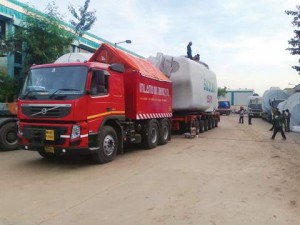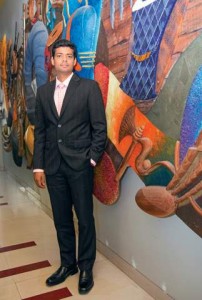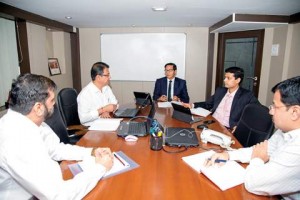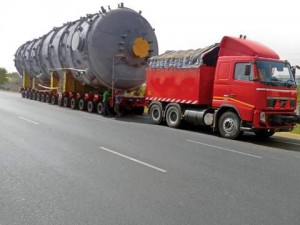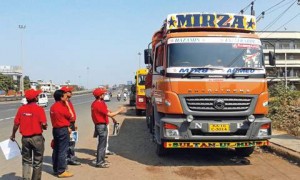A business arm of Indian Couriers, Inland World Logistics is looking for growth by acquiring modern trucks. It is also looking at a bigger role in logistics.
Story by:
Ashish Bhatia
Inland Couriers was established in 1971 at Kolkata with an aim to cater to the courier requirements in the Eastern and North-eastern parts of the country. In a span of three decades, the company has grown to diversify into a multi-vertical business valued at Rs. 2200 crore. With a workforce of 5,000 employees and offices across 550 locations in India, Inland Couriers got a shot in the arm when it won a Supreme Court Judgement in 1971. At that time, courier was disregarded as a business model. Not only did Inland Couriers get an opportunity to exist, it also got an opportunity to grow. Offering diverse services – from packaging, power and logistics to real estate, the company, clocking a CAGR of approximately 25 per cent Year-On-Year (YOY), operates under business verticals like Inland World Logistics, Inland Power, Inland Automate, Inland Bearing Centre, BE Gold, Bharatiyam Food and Beverage, Gopalpur Tea, Inland Logipark and Inland Lifescapes. Inland World Logistics (IWL) is the flagship company of Inland Couriers, and offers point to point services to over 350 locations. According to Praveen Somani, Director, Inland Group, the work is done in half the delivery time when compared to the industry average. Rolling out a 96-hour delivery service to Kolkata as part of an express premium module, IWL observed that despite the high costs, customers availed of the premium services since delivery was cut-down from nine days to just five days, made possible by an entire value chain upgrade. To fuel its growth plans and go pan-India, IWL’s fleet began earning itself a payload on their return trip as well. The volumes weren’t as much though, and IWL turned to the corporates.
Claiming to offer better service than an old hand at express distribution, Gati, IWL’s services have come to include consolidated cargo (sundry and bulk) movement, premium segment movement, corporate business, bulk transportation, Over Dimensional Cargo (ODC), 3PL cargo and freight forwarding. In its quest to keep growing, IWL, according to Somani, is looking at Container Freight Station (CFS) and Logistical Park (LP) as lucrative options. “Rather than cause a disruptive change by opting for an easier strategy, like that of lowering the prices, we are currently operating on a 80:20 scale where 80 stands for basic transportation and 20 stands for value adds. For us, Container Freight Station (CFS) and Logistical Park (LP) seem lucrative options.,” said Somani. IWL, according to Somani, is a Rs. 850 crore company in terms of logistics. It is looking at a valuation of Rs. 5000 crore by 2022. Banking on new investments and new services to drive growth, Somani is aware that the need will be for a robust fleet. “Fleet is very important for us. Almost 95 per cent of our movement is on road and the remaining five per cent is by rail. The choice of what fleet we have is also very important,” Somani stated.
Operating on a fleet owner-associate business model, IWL owns 151 vehicles. It has 850 vehicles attached to it. Aiming to acquire 250 vehicles and hike the number of attached vehicles to over 4,000, IWL, quipped Somani, is not a fleet manager. It is instead a logistics aggregator that prefers associates, partners with vehicles who can co-invest over the longer-term. Of the current associates that IWL has, 68 are long-term ones. One of these provides a fleet of 100 vehicles. There’s also an associate who provides one vehicle. The proportion of associates with smaller size of fleets is higher. Most of them according to Somani are from Rajasthan. While the associate fleets are devoted largely to bulk commodities like steel, and coil movement, IWL’s own fleet deals with the consul and premium cargo. Averred Somani, “Of the Rs. 850 crore business we do, about Rs. 250 crore is being serviced by the fleet at hand, both owned and that of the associates. This creates a room to bring in additional associates for the substantial rest to be handled.” Having 11 pullers and 126 hydraulic axles, IWL is looking forward to acquiring Mercedes-Benz trucks as it expands its fleet. Somani expressed an opinion that Scania will emerge as a formidable player over a period of time. He added, “We are expecting traction to rise beyond the current levels, especially in the case of the neighbouring markets of Nepal, Bhutan and Bangladesh.”
With every puller in the IWL fleet handling six to eight orders a year, the recent development where the Hydraulic Trailer Association has made it possible to secure an online approval for cargo below 100 tonnes, should help to grow, according to Somani. He said that it would eliminate the middle men holding fleet owners at ransom. Opining that a lot needs to be done by the government yet, Somani exclaimed that the challenges in the handling of ODCs, super ODCs especially (of 18-inch dia.), call for the need to dismantle them owing the government’s limit set for 15-inch dia. He also drew attention to the need for carrying out a survey prior to transporting an ODC, expressing that IWL has successfully executed assignments like the transportation of Bombardier rail rakes for Delhi. The most challenging assignment till date for IWL was the one contracted by the Jindal Group. The challenges spanned from having to alter routes, to cross small villages with a large 250 metric-tonne cargo. “We were the only company to complete the job despite a period of total of nine months as against an expected time of three to four months,” beamed Somani. He said that IWL has been appreciated by its clients to deliver a high level of service. “An order gone wrong could negatively impact the brand value,” he added.
Apart from Mercedes-Benz trucks, IWL is also looking at acquiring Tata Prima trucks in an effort to have a fleet that is capable of carrying a cargo between 40 and 250-tonnes. IWL is looking at purchasing four Tata Primas in the near future. It already has one Prima in its fleet. Influencing the acquisition of Prima is the fact that Volvo and Mercedes-Benz trucks can prove to be expensive in case the cargo is lighter than these trucks are meant to deliver. What tilts the scales in favour of the Prima according to Somani is the fact that the company’s fleet drivers prefer them. They are also easy to maintain, and anything other than a Tata would call for the fleet drivers to be trained into driving them. Informed Somani that during the course of 2014 and 2015, IWL inducted 60 (16-tonne) Tata trucks into its fleet. The improvement in the market dynamics and infrastructure is encouraging IWL to look at bigger, 24 to 28-tonne trucks.
Of the opinion that a lot of big announcements are yet to reflect at the ground level, Somani categorically expressed that there is a need to minimise the red tape. What good is a port without a Container Freight Station (CFS), he questioned in reference to the government’s announcement for new ports. On GST, and how it may impact the Indian logistics industry, Somani remarked that distribution may not see a big change even though documentation, bureaucratic processes in terms of sales tax and combined taxes may get a boost. Fine tuning its processes to improve efficiency by investing in an Enterprise Resource Planning (ERP ) platform, GPS based fleet management system and separate training modules for drivers and the workforce, IWL is keen to make a difference. Concluded Somani, “India yearns for better infrastructure in its ode to become a global logistics hub. It needs to embrace modern technology like palletising systems. In India, logistics accounts for 13 per cent of the GDP cost. In Germany it is nine per cent. Costs could be brought down by increasing efficiency. At Inland, we are looking to make a difference by taking on a bigger role.”



